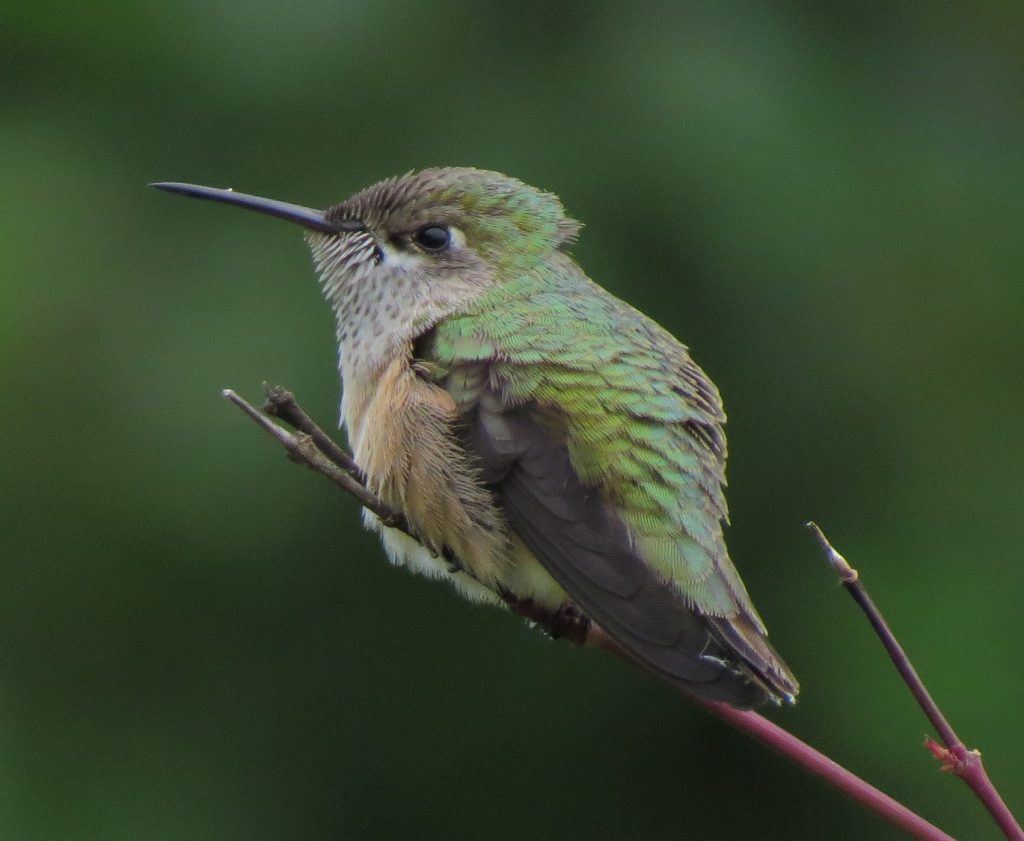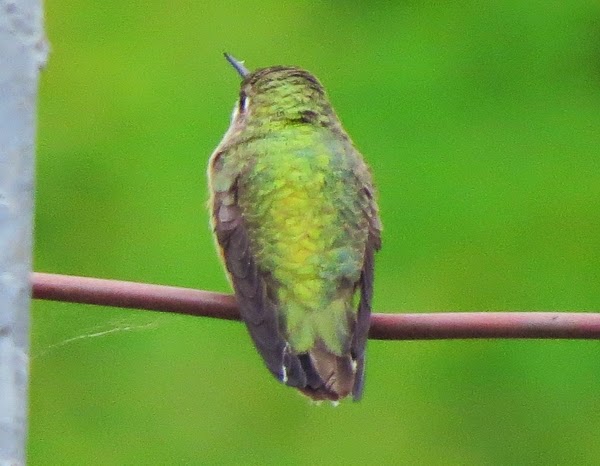While visiting my mother in Umpqua on May 16, 2015, I noticed a male Calliope Hummingbird at her feeder. Buzzing merely 6 feet away from me, the small green hummingbird with purple fingers on its throat was pretty noticeable and distinct! I did not have my camera on me, so didn’t obtain a photo. A few hours later, I was looking out the window to see if the male Calliope would show up again. I spotted a small, short-billed, short-tailed hummingbird at the feeders again, so I grabbed my camera and bins and stepped outside. To my surprise, it was not the male Calliope I had seen previously, it was a female or immature type small hummingbird.
I consider female hummingbirds to be one of the most difficult identification challenges for birders. Hummingbirds are SMALL! In fact, the bird I was looking at is one of the smallest, lightest species in North America (weighing less than a penny). And another thing, they move FAST! In addition, some of the most useful marks are on the spread tail, which one can almost never see well enough and long enough in the field for the characteristics to be useful. One needs to get lucky and/or be at the right angle to take lots of photos to get a useful image! So, … I had a challenge in front of me. Come along with me on an adventure and in the process, become familiar with a female Calliope Hummingbird and female/immature Rufous Hummingbirds!
At first glance the bird had the general characteristics of a female Calliope Hummingbird: small size, and relatively short-tailed, and short-billed. However, size assessment is a skill with which humans have only moderate success, so I consider my initial judgement of size to be an indication that I should take a closer look for more objective characteristics. On the positive side, however, I was perceiving three characteristics that suggested Calliope Hummingbird, not merely body size. (I also heard the call, which was somewhat higher and somewhat clearer than the female Rufous.) The primary confounding factor this time of year is that recently fledged Rufous Hummingbirds can have relatively short bills and short tails (as with many immature birds). So, what would tell me for sure that I was looking at a female Calliope Hummingbird and not a young Rufous Hummingbird?
First, let’s go back to body size. Was my assessment of size correct? If I had seen the bird alone, I would have less confidence in my assessment. However, there were at least 6 female Rufous Hummingbirds in close proximity to this bird, both at the two feeders and perched on nearby fencing, making close comparison possible, so I was pretty confident in my assessment, but can I see that in my photos? The image below shows a female Rufous Hummingbird on the left, and the female Calliope Hummingbird on the right. The birds were not sitting side by side in real life. However, I purposely took a photograph in which one bird was in the top half of an image and the other in the bottom half, each at the same distance in front of my camera. Since each was the same distance from the camera, I felt it safe to cut out the Calliope and paste it next to the Rufous for comparison (see below). While these birds are not in the same posture, you can see that the Rufous is taller and wider than the Calliope. So, I think this shows it really is a smaller bird.
One of the next things to look for in a flying bird is a lack of rufous in the tail. The problem with this in real life is that it is often hard to see rufous even in the tail of a female Rufous Hummingbird (especially an immature female where it is quite reduced), so “not seeing” rufous isn’t really strong evidence of a lack of rufous in the tail. In the field, to be sure there is no rufous in the tail, one needs to witness several spread-tail events at close range. However, in this case, I had my camera, so let’s take a look…. Below is one view, showing the white tips of the outer 2 or 3 tail feathers, their black mid-vanes, and then greenish gray uppertail coverts—no rufous. (This photo also shows a stubby little tail.)
Here (below) is another view, showing a little more of the tops of the feathers. Again, there is white, black, and green—no rufous. I never did get a spread tail shot from the back.
So the tail looks good for Calliope; even a recently fledged Rufous would have rufous in the upper (basal) parts of the outer tail feather at this angle.
Another thing to look for is the juxtaposition of the tips of the wings and tail. When the bird is perched, the tips of the primaries on the Calliope Hummingbird are near to the tips of the tail (sometimes slightly longer in males, shorter on females, but not much). Let’s see how this one looks….
What I see in the photos above and below are primary tips that are very close to the tips of the tail feathers. In fact, you will notice in these front and rear views something that is common when assessing primary/tail tip positions in hummingbirds: views from the front and back can result in different evaluations of the position of primary and tail tips. This bird has the tail and wing tips in close proximity. When wings and tail are not so aligned (and wing and tail tips are farther apart) the differences from front and back can be even more striking (so be aware!). The best angle for assessing tail and wing positions is from the side.
You may notice something interesting in the above photo. Do you notice the worn, brown tail feathers? And, just visible between the top brown tail feather and the left wing is a clean, smooth, black tail feather coming in. More on that later….
To contrast tail and wing lengths in the Rufous Hummingbird, following is a photo of an adult female Rufous taken the same time and day at my mom’s place, showing the much longer tail compared to the wingtips.
Let’s now look at one more useful characteristic of Calliope Hummingbirds. Calliopes have relatively broad outer primaries, in contrast to the relatively narrow primaries of the Rufous Hummingbird. Compare the shape of the female Rufous Hummingbird primaries above with the female Calliope Hummingbird below.
Early on I mentioned that some young Rufous Hummingbirds can look somewhat like Calliopes because of their shorter tails (tip closer to the tips of the primaries) and shorter bills. Rufous Hummingbirds right out of the nest can show very short tails and bills, but these just-fledged birds typically exhibit behavior that suggests they are “newbies”; for example, slower, less aggressive flight, perching near the ground, and less fear of being approached. It is the birds that are a bit more fully feathered, out of the nest for a few more days or a week or two, and are not obviously “new” that are the challenge. Following are a few photos of young Rufous Hummingbirds from mid-July in the Douglas County Cascades, in their first few weeks/months of life, each of which has some similarities to a female Calliope, but which also show features distinguishing it from Calliope.
Hmmm. Here (above) is another cute little greenish (not a lot of rufous) hummingbird. From this angle, with the tail rather short and all folded up, we cannot see any rufous in the tail, the bird looks small, kinda short-billed and short-tailed. We cannot see the tips of the primaries, so we cannot really tell how wide they are, but they certainly do not project beyond the tail. So what can we see? 1) Feathers on the back of the bird (and even on top of the head) have buffy/rufous edges, somewhat brighter and broader down toward the tail; this is typical in immature female Rufous Hummingbirds, typically absent in female Calliope and much brighter and more extensive in immature male Rufous. 2) The area between the eye and bill shows a nice solid, unbroken blackish line, which again is typical of fresh-plumaged immature/female Rufous Hummingbirds.
Okay, this one is a bit easier. Why? 1) The primaries are narrow, 2) the primaries fall obviously short of the tip of the tail even while hanging below (which, remember, means if they were above the tail would put even more distance between them and the tail tip), 3) there is obvious rufous on the lower back/rump area, and 4) there is a solid, though a little crooked, dark line from the eye to the bill. All these point to immature Rufous Hummingbird.
This one has a bit of the “cute puffball, short bill, short tail” look. However, 1) the primaries clearly narrow toward the end, 2) the primaries are substantially shorter than the tail, and 3) there is a solid dark line from the eye to the bill. All these point to immature Rufous Hummingbird. It’s hard to make out how much rufous is on the tail or lower back.
Getting back to the Calliope Hummingbird, let’s take a closer look at that Calliope tail again (below)…. Notice the brown, worn tail feather(s)? What is one important thing that this tells us? Well, one thing is that this is not a recently fledged bird; it is an old worn feather, likely 9 or more months old. So, this is another piece of evidence that tells us this is not a recently fledged hummingbird. This is also interesting because Calliopes are reported to molt on their wintering grounds, so why does this bird still have several old tail feathers? Probably because it is a one-year-old bird. Many species of birds retain a few old feathers into their second calendar year.
While grainy, this cropped photo also shows the broad primaries quite well.
Well, this brings us to the end. 🙂
I hope you have enjoyed and benefited from this “tour” of a female Calliope Hummingbird, in comparison to Rufous Hummingbirds. Female hummingbirds may be difficult to distinguish in many cases, but the more intently you look the more you will perceive.
There’s always more to learn, so if you see any mistakes I’ve made or have additional insight, please share! Thank-you to Stacy Burleigh for a review and helpful suggestions for clarity!
Useful references for identifying hummingbirds (beyond standard field guides):
*Sheri L. Williamson’s “Hummingbirds of North America” (Peterson Field Guide Series)
*Steve N.G. Howell’s “Hummingbirds of North America” (Natural World)














This Post Has 2 Comments
Oh, I learned so much! Thank you Matt! Now if I just had some female Calliope's to practice on with my female Rufous.I have not seen my male Calliope since May 6th 🙁
What a fun account and great photos! I'm amazed at the difference in primaries. Such cute birds!!